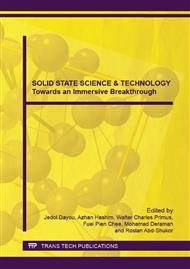p.67
p.73
p.79
p.85
p.91
p.96
p.103
p.108
p.113
ESR Study of K-Mo2C for Increased Catalytic Properties
Abstract:
The presence of potassium in molybdenum carbide morphology has been reported to increase the selectivity and reactivity of its catalytic properties. Potassium with its tendency to donate electron will enhance the electron density at the surface of catalyst by donating its electron at the vacant orbital framework either to carbon or metal moiety. This phenomenon will cause temporary paramagnetic properties of the catalyst and can be easily detected using an ESR spectrometer. In this paper, an ESR-based study to identify and prove that donating electron does take place at Mo2C after being promoted with potassium was conducted. Introduction of H2 and UV radiation were also carried out for comparison.The result from ESR spectra showed that in the absence of potassium in the Mo2C, no ESR signal was observed. However, in the presence of potassium, a singlet peak with g value ca. 1.9723 was found. The presence of a single peak indicated that the donated electron did not interact with any nearby nucleus in the surroundings. Deviation value of 2.0023 for free electron, indicates that this donated an electron probably interacted with an empty 4d orbital from molybdenum or 2p orbital from carbon.In the introduction of H2 gas and UV radiation, the finding showed that an increasing trend of singlet peak in the ESR spectrum earlier was observed. The trend indicated that the splitting of H2 by UV radiation generated new electron and joined the donated electron from K circulating at the surface of K-Mo2C morphology without interacting with another nucleus.
Info:
Periodical:
Pages:
91-95
Citation:
Online since:
June 2015
Keywords:
Price:
Сopyright:
© 2015 Trans Tech Publications Ltd. All Rights Reserved
Share:
Citation:


